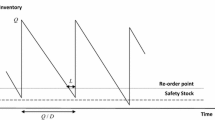Abstract
In this chapter, we evaluate the behavior of fuzzy estimations of demand for releasing manufacturing orders in a Vendor-Managed Inventory (VMI) supply chain, which is based on a collaborative deal between retailer and manufacturer, and focuses on the interchange of information about demand and inventory levels. The supply chain considered consists of an end consumer, a retailer and a manufacturer. A system dynamics model with fuzzy estimations of demand has been constructed for supply chain simulation. Fuzzy numbers are used to model fuzzy estimations of demand. With a numerical example, we show that the bullwhip effect can be effectively reduced at the level where fuzzy orders exist and that the fill rate reached improves at the retailer level.
This work has been funded by the Universitat Politècnica de València projects: ‘Material Requirement Planning Fourth Generation (MRPIV)’ (Ref. PAID-05-12) and ‘Quantitative Models for the Design of Socially Responsible Supply Chains under Uncertainty Conditions. Application of Solution Strategies based on Hybrid Metaheuristics’ (PAID-06-12).
Access this chapter
Tax calculation will be finalised at checkout
Purchases are for personal use only
Similar content being viewed by others
References
Balan, S., Prem, V., Pradeep, K.: Reducing the Bullwhip effect in a supply chain with fuzzy logic approach. Int. J. Integr. Supply Manag. 3(3), 261–282 (2007)
Campuzano, F., Mula, J.: Supply Chain Simulation: A System Dynamics Approach for Improving Performance. Springer, Heidelberg (2011)
Campuzano-Bolarin, F., Mula, J., Peidro, D.: An extension to fuzzy estimations and system dynamics for improving supply chains. Int. J. Prod. Res. 51, 3156–3166 (2013)
Campuzano, F., Mula, J., Peidro, D.: Fuzzy estimations and system dynamics for improving supply chains. Fuzzy Sets Syst. 161, 1530–1542 (2010)
Cannella, S., Povoa, A.P., Framinan, J.M., Relvas, S.: Metrics for bullwhip effect analysis. J. Oper. Res. Soc. 64, 1–16 (2012)
Cannella, S., Ciancimino, E.: On the bullwhip avoidance phase: supply chain collaboration and order smoothing. Int. J. Prod. Res. 44, 6739–6776 (2010)
Carlsson, C., Fullér, R.: On possibilistic mean value and variance of fuzzy numbers. Fuzzy Sets Syst. 122, 315–326 (2001)
Carlsson, C., Fullér, R.: Soft computing and the bullwhip effect. Econ. Complex. 2, 1–26 (2000)
Dejonckheere, J., Disney, S.M., Lambrecht, M.R. Towill, D.R.: Production and inventory control; the variability trade off. In: Proceedings of the 9th EUROMA. Copenhagen, Denmark, 2–4 June 2002
Disney, S.M., Naim, M.M., Potter, A.: Assesing the impact of e-business on supply chain dynamics. Int. J. Prod. Econ. 89, 109–118 (2004)
Disney, S.M. Towill, D.R.: The impact of vendor managed inventory on the Bullwhip effect in supply chains. Proceedings of the 16th International Conference on Production Research, Prague (2001)
Dubois, D., Prade, H.: Possibility Theory: An Approach to Computerized Processing of Uncertainty. Plenum Press, New York (1988)
Dubois, D., Prade, H.: The mean value of a fuzzy number. Fuzzy Sets Syst. 24, 279–300 (1987)
Forrester, J.W.: Industrial Dynamics. The MIT Press, Cambridge. Reprinted by Pegasus Communications, Waltham (1961)
Fransoo, J.C., Woters, M.J.F.: Measuring the bullwhip effect in the supply chain. Supply Chain Manag. Int. J. 5, 78–89 (2000)
Goetschel, R., Voxman, W.: Elementary fuzzy calculus. Fuzzy Sets Syst. 18, 31–43 (1986)
Heyman, D., Sobel, M.: Stochastic Models in Operations Research, I edn. McGraw-Hill, New York (1984)
Holmstrom, J., Framling, K., Kaipia, R., Saranen, J.: Collaborative Planning Forecasting and Replenishment: New Solutions Needed for Mass Collaboration. Supply Chain Manag. 7(3), 136–145 (2002)
John, S., Naim, M.M., Towill, D.R.: Dynamic analysis of a WIP compensated decision support system. Int. J. Manuf. Syst. Des. 1, 283–297 (1994)
Kahn, J.A.: Inventories and the volatility of production. Am. Econ. Rev. 77, 667–679 (1987)
Kristianto, Y., Helo, P., Jianxi, J., Sandhu, M.: Adaptive fuzzy vendor managed inventory control for mitigating the bullwhip effect in supply chains. Eur. J. Oper. Res. 216(2), 346–355 (2012)
Lee, H.L., Padmanabhan, P., Whang, S.: The bullwhip effect in supply chains. Sloan Manag. Rev. 38, 93–102 (1997a)
Lee, H.L., Padmanabhan, P., Whang, S.: Information distortion in a supply chain: the Bullwhip Effect. Manag. Sci. 43, 543–558 (1997b)
Lin, K.P., Chang, P.T., Hung, K.C., Pai, P.F.: A simulation of vendor managed inventory dynamics using fuzzy arithmetic operations with genetic algorithms. Expert Syst. Appl. 37, 2571–2579 (2010)
Magee, J.F.: Production Planning and Inventory Control, pp. 80–83. McGraw-Hill Book Company, New York (1958)
Silver, E.A., Pyke, D.F., Peterson, R.: Inventory Management and Production Planning and Scheduling. Wiley, New York (1988)
Sterman, J.D.: Business Dynamics: Systems Thinking and Modelling for a Complex World. McGraw-Hill, Boston (2000)
Wangphanich, P., Kara, S., Kayis, B.: Analysis of the bullwhip effect in multi-product, multi-stage supply chain systems–a simulation approach. Int. J. Prod. Res. 48, 4501–4517 (2010)
Xiong, G., Helo, P.: An application of cost-effective fuzzy inventory controller to counteract demand fluctuation caused by bullwhip effect. Int. J. Prod. Res. 44(24), 5261–5277 (2006)
Zarandi, F., Pourakbar, M., Turksen, I.B.: A Fuzzy agent-based model for reduction of bullwhip effect in supply chain systems. Expert Syst. Appl. 34, 1680–1691 (2008)
Author information
Authors and Affiliations
Corresponding author
Editor information
Editors and Affiliations
Rights and permissions
Copyright information
© 2014 Springer-Verlag Berlin Heidelberg
About this chapter
Cite this chapter
Campuzano-Bolarín, F., Mula, J., Peidro, D. (2014). Fuzzy Estimations and System Dynamics for Improving Manufacturing Orders in VMI Supply Chains. In: Kahraman, C., Öztayşi, B. (eds) Supply Chain Management Under Fuzziness. Studies in Fuzziness and Soft Computing, vol 313. Springer, Berlin, Heidelberg. https://doi.org/10.1007/978-3-642-53939-8_10
Download citation
DOI: https://doi.org/10.1007/978-3-642-53939-8_10
Published:
Publisher Name: Springer, Berlin, Heidelberg
Print ISBN: 978-3-642-53938-1
Online ISBN: 978-3-642-53939-8
eBook Packages: EngineeringEngineering (R0)




